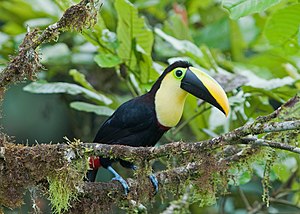Sea toucan
| Sea toucan | ||||||||||
|---|---|---|---|---|---|---|---|---|---|---|

Sea toucan ( Ramphastos brevis ) |
||||||||||
| Systematics | ||||||||||
|
||||||||||
| Scientific name | ||||||||||
| Ramphastos brevis | ||||||||||
| Meyer de Schauensee , 1945 |
The coastal toucan ( Ramphastos brevis ) is a species of bird in the toucan family. It occurs exclusively in northern South America. Unlike the yolk toucan or spotted toucan , the coastal toucan is rarely shown in zoological gardens.
The IUCN classifies the coastal toucan as ![]() (= least concern - not endangered). The exact population is not known, but the coastal toucan is still described as common in some regions of Ecuador .
(= least concern - not endangered). The exact population is not known, but the coastal toucan is still described as common in some regions of Ecuador .
Appearance
The coastal toucan has a body length of 48 to 55 centimeters and a wing length between 18.2 and 21.4 centimeters. The beak length of the males is 12.7 to 16.3 centimeters, that of the females is slightly less with 11.4 to 13.9 centimeters. The weight varies between 365 and 482 grams. There is no noticeable sexual dimorphism , females tend to be a little smaller and the slightly shorter beak makes the head appear a little stronger.
Plumage and beak
Adult coastal toucans have black plumage on the upper side of the body. From the forehead to the middle of the back, the individual feathers have a deep red-brown tip. The lower back is black up to the trunk, the upper tail-coverts are white. The tail is glossy blue-black. The chin, feathered parts of the face and throat are bright yellow. There is a narrow red band at the transition from the throat to the chest. The underside of the tail is red, the rest of the underside of the body is black, with dark reddish brown from chest to belly.
The bill is long, the upper bill is slightly curved. A fine black line runs along the base of the beak. The lower bill is black, the upper beak is black on the lower side and yellow on top, the separation of the color runs in a straight line from the upper beak base to the tip. The featherless skin of the face is green to green-yellowish. In some individuals it also has a bluish shimmer, others are yellowish behind the eye. The eye itself is yellow-green, green, or gray-green. The legs and feet are blue-green, blue-gray, gray, or slate-gray.
Young birds are a little more dull in color. The yellow on the chest in particular is less bright, the red plumage areas show an orange tint.
Possible confusion
It can be confused with the much larger golden-throated toucan , with which the coastal toucan is otherwise very similar. The easiest way to tell apart is by the sound utterances. The sea toucan also has a shorter beak that looks a bit greener on the sides. Otherwise, only the yolk toucan occurs in the distribution area of the coastal toucan , although it has a predominantly black beak.
Distribution area and habitat
The coastal toucan occurs in western Colombia and Ecuador. There it inhabits moist forests and forest edge zones. It occurs mainly in the lowlands. However, it is occasionally observed at the foot of the Andes up to an altitude of 1500 meters. The distribution area overlaps with that of the golden-throated toucan and occasionally the two species are also associated with each other. While feeding, it occasionally uses the same trees as the collared arassari .
Way of life
Sea toucans are usually seen in pairs or small flocks, occasionally as many as 14 individuals. They find their food mainly in the tops of trees. The birds occasionally use trees standing alone in meadows or other cultivated land. The food spectrum has not yet been adequately investigated. Most of the diet is likely to have fruits, but they probably also eat insects. To what extent they eat nestlings and eggs like other Ramphastos species is not yet known.
Similar to feeding behavior, reproductive behavior has so far only been insufficiently investigated. Clutch size, incubation time and nestling time are not known. Presumably they resemble those of the other large species from the genus of the real toucans .
supporting documents
literature
- Werner Lantermann: Toucans and Arassaris. Filander Verlag, Fürth 2002, ISBN 3-930831-46-5 .
- Lester L. Short and Jennifer FM Horne: Toucans, Barbets and Honeyguides. Ramphastidae, Capitonidae and Indicatoridae . Oxford University Press, Oxford 2001, ISBN 0-19-854666-1 .
Web links
- BirdLife Factsheet on the Sea Toucan
- Ramphastos brevis inthe IUCN Red List of Threatened Species 2013.1. Listed by: BirdLife International, 2012. Retrieved October 23, 2013.

